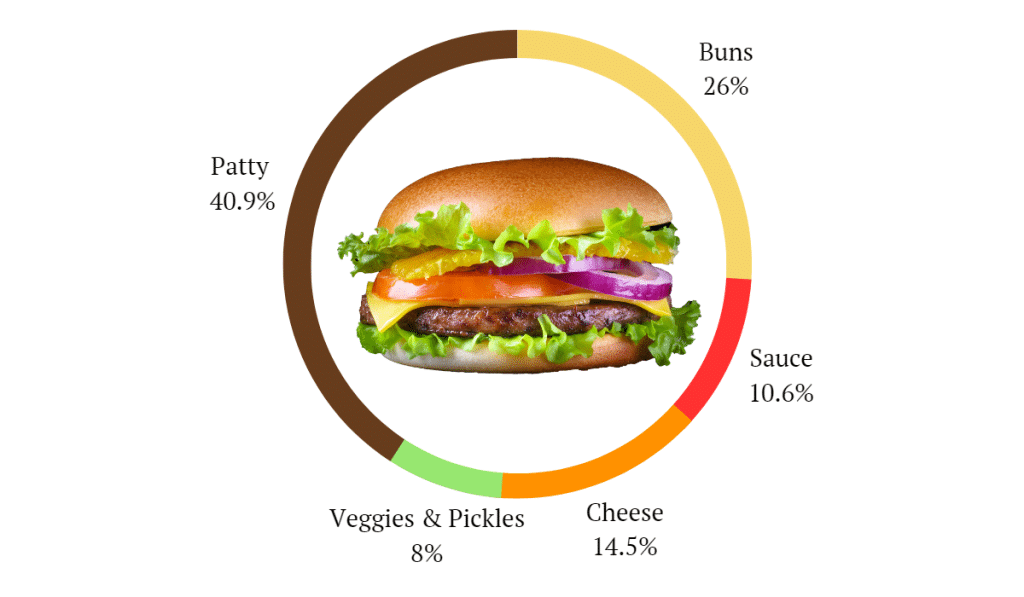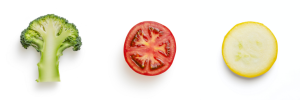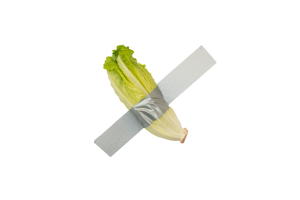Believe it or not, we can make burgers healthy. My diet included burgers all the time, even when I am losing weight, and I lost more than 30 kg. I will show you how I fine-tuned my burger calories without compromising the flavor. Our main goal today is to review all of its components and look at how we can make it suitable for our nutrition to consume regularly. We will also take a look at other additions to the burger that makes it unique, and its overall nutritional impact. Let’s begin.
There is 800-1000 kcal in one burger sandwich. 67% of these calories come from the patty and the buns, and it is greatly dependent on the type and the serving size of these ingredients.

Table of Contents
Burger Buns Calories
The buns provide the second largest amount of calories in a burger. Both the buns and the patties supply the majority of the burger’s nutritional value. With the bun supplies the carbs, and the patty supplies the protein obviously. Some buns provide fat in addition to the carb, but the nutritional end result will be the same due to the fact that it is limited by size. There are different types of buns, and I provided a general overview of their nutritional breakdown. Keep in mind this may vary a little bit depending on how big your sandwich is and how much alteration is done to the recipe. If you want to explore additional types of bun then keep in mind that they will have about the same nutritional value. The range for the calories coming from the buns is usually 230-300 kcal per bun with 260 kcal being the average.
| Calories | Protein | Fat | Carbs | Fiber | |
|---|---|---|---|---|---|
| Plain Buns | 249 | 6.2 | 4 | 46.4 | 1.4 |
| Potato Buns | 297 | 6.7 | 8.6 | 47.8 | 1.9 |
| Pretzel Buns | 228 | 5.2 | 5.4 | 39 | 1.4 |
| Cibata Buns | 273 | 7.8 | 0.7 | 57.2 | 2 |
| Kaiser Buns | 275 | 7.3 | 5.2 | 48.9 | 1.6 |
| Brioche Buns | 247 | 6.6 | 4.1 | 45.2 | 1.5 |
*Amounts listed per 1 bun
Tomatoes, Lettuce, Pickles, and Onions
Raw vegetables generally don’t contribute many calories and are considered a healthy part of the meal. In a classic burger, vegetables that commonly go onto a burger are tomatoes, lettuce, pickles, and onions. If you want to add any other vegetable, then know that it won’t affect the overall nutrition much. If you’re concerned that the pickle is not a raw vegetable, then fear not. The pickling or the fermentation process does not affect the nutritional value. Here are the nutritional facts for the raw vegetables that go on your burger:
| Calories | Protein | Fat | Carbs | Fiber | |
|---|---|---|---|---|---|
| Tomatoes | 18 | 0.9 | 0.2 | 3.9 | 1.2 |
| Lettuce | 14 | 0.5 | 0.2 | 3 | 0.6 |
| Pickles | 11 | 0.3 | 0.2 | 2.3 | 1.2 |
| Onion | 40 | 1.1 | 0.1 | 9.3 | 2.1 |
*Amounts listed per 100 grams
On the other hand, if decided to cook these vegetables, then you’ll be adding fat. For example, if decided to top your burger with caramelized onion you’ll likely caramelize them with butter. You will need 1-2 tablespoons per serving and that’s 120-240 kcals added to your burger calories. If you’re trying to produce a mushroom sauce then you’ll need cream and that’s also fat, but you won’t need much of it. More on sauces later.
Burger Cheese Calories
Most decent burgers have cheese, and I would personally feel that there’s something missing if have one without cheese. Cheese is the third largest contributor to the burger calories after the patty and the buns. They’re an excellent source of protein, calcium, phosphorus, vitamin A & B12. The most common types used in burgers are Cheddar, Monterey Jack, and American cheese. As I mentioned before in my article about pizza calories, cheese can be classified into two types that will help us understand their nutrition. There are soft cheeses and hard cheeses, and some in between. The softer the cheese, the more fat it contains, and vice versa. That’s why cream cheeses are essentially “dairy cream”. Here is the nutritional breakdown of the three cheeses I mentioned earlier:
| Calories | Protein | Fat | Carbs | Fiber | |
|---|---|---|---|---|---|
| Cheddar | 403 | 24.5 | 33.1 | 1.3 | 0 |
| Monetary Jack | 373 | 24 | 30 | 0.7 | 0 |
| American Cheese | 371 | 18 | 32 | 3.7 | 0 |
*Amounts listed per 100 grams
Burger Patty Calories
Here comes the star of the show, the burger patty. The patty provides the most amount of calories, and these calories depend mainly on the type and amount of beef. The main problem here is that the beef need to have a high-fat content, otherwise the patty won’t hold and crumble when it’s cooked. On the other hand, increasing the fat content increases the total calories. The patty fat also contributes a lot to the flavor, and decreasing it would turn the burger bland. To achieve the perfect balance, a 20% fat patty would do the trick. Keep in mind that a big amount of the fat renders out of the meat when you cook it, just check your pan after you finish grilling that burger, do you remember adding that much oil? Here is the nutritional breakdown of your ground beef:
| Calories | Protein | Fat | Carbs | Fiber | |
|---|---|---|---|---|---|
| Beef, 70% Lean, Raw | 254 | 17.2 | 20 | 0 | 0 |
| Pork, 72% Lean, Raw | 314 | 15 | 28 | 0.7 | 0 |
*Amounts listed per 100 grams
Other variations that come to my mind include:
- Double Patties. After experimenting with double patties burger, I decided to divide the same patties into two smaller patties. The reason for this is firstly I want to be able to bite the sandwich, and secondly, the thin patties give me a crispy texture. So if I want a crispier burger I would make a double patty, and If I want a juicy burger I would do a single, big patty. What this means is the nutritional values are the same. If you do decide to have two large patties be aware that you’re having twice the amount of calories.
- Pork Patty. Pork has almost the same nutritional value as beef provided they’re both cooked the same way and have the same fat percentage. So if you’re a fan of a pork burger, your calories won’t change much.
Burger Sauce Calories
Unless you’re going to dip your whole burger in sauce, you’re not going to add much of it to your burger. Usually, 1-2 tablespoons is enough per burger. That’s why burger sauce won’t contribute much to the overall calories. The most common sauces used in burgers are mustard, ketchup, and mayo. Mustard and mayo contribute similar amounts of calories and ketchup contributes the least. Sauces will contribute 70-120 kcal per burger depending on how much sauce you add. Of course, there are many other sauces that you can add to a burger, like the famous mushroom cream sauce. Any sauce will end up contributing the same amount of calories because if you add too much the burger will be messy. Sauces are an integral part of the burger, they provide flavor and added moisture and elevate the burger to a whole new level.
Here are the nutritional facts about some sauces used in burgers per 1 tbsp:
| Calories | Protein | Fat | Carbs | Fiber | |
|---|---|---|---|---|---|
| Mustard | 53 | 2.8 | 3.2 | 3.9 | 1.7 |
| Ketchup | 15 | 0.3 | 0.1 | 3.8 | 0 |
| Mayo | 57 | 0.1 | 4.9 | 3.5 | 0 |
*Amounts listed per 1 tbsp
Additional toppings
You might fancy additional toppings on your burger just as a change of pace. These toppings can sometimes add a new flavor profile and increase its depth. Some of the most common toppings are:
- More Veggies. For example chilis, a lot of sometimes feel brave and want to try a spicy, peppery burger. Adding chilis to a burger is essentially adding vegetables like tomatoes, lettuce, and onion. Nothing major will happen to the overall calories.
- Bacon. Despite it adds a ton of flavor, bacon can add a lot of fat to the sandwich. Even if you cook it and most of the fat renders out, it still packs a punch. Be careful if you add too much bacon because you will need to work out those calories.
- Eggs. can be a wonderful addition to the burger, especially if you pair it with a hot sauce. Eggs add equal amounts of protein and fat, not as much as bacon, and can be added in moderation.
These are some of my favorite toppings, also some of the most common. Let me know if there’s anything else you want me to discuss in the comment section.
| Calories | Protein | Fat | Carbs | Fiber | |
|---|---|---|---|---|---|
| Bacon | 541 | 37 | 41.8 | 1.4 | 0 |
| Eggs | 143 | 12.6 | 9.9 | 0.8 | 0 |
*Amounts listed per 100 grams
A Healthy Burger Recipe
Here are some blueprints for healthy burger recipes. You can take these fundamentals in any direction you want and play with them. Have fun and tailor the recipe to your liking and your nutritional needs.
- Classic: All of that we mentioned above. Add Buns, tomatoes, lettuce, pickles, cheese, and sauce to the patty. You can’t go wrong with the classics
- Mushroom: caramelize onions and mushrooms with butter in a pan, deglaze with a little bit of water, Worchestchire sauce, and cream. You’ve got yourself the creamy mushroom sauce. Top the patty with that and you’re off to the races.
- Chargrilled: I got the inspiration for this recipe from a middle eastern kebab recipe, and it’s perfect if you have access to an outdoor barbeque grill. The premise of this recipe is simple: chargrill everything. Chargrill the tomatoes, onions, and patty. Add the pickles and the lettuce raw. You can either chargrill tomato slices and add a barbeque sauce of your liking, or chargrill whole tomatoes and mash them to use as a chunky sauce on top of the patty.
Here are the nutritional values for these sandwiches:
| Calories | Protein | Fat | Carbs | Fiber | |
|---|---|---|---|---|---|
| Classic Burger | 928 | 17.9 | 18.1 | 66.7 | 3.6 |
| Mushroom Burger | 970 | 18.5 | 24.8 | 62.2 | 3.3 |
| Chargrilled Burger | 924 | 17.8 | 18 | 65.8 | 3.4 |
*Amounts listed per 1 sandwich
Eat your burger, leave out your fries (and Drink)
you knew that we can’t talk about the burger without mentioning the fries. It is and it is not a part of the burger. If you have with your burger, you’re essentially just having carbs and fat (empty calories), without the added value of the protein and fiber. As I have shown you, an average burger sandwich can contain around 850-1000 Kcals. If you add fries to that, you will be adding an additional 356 kcal per 117 grams (a medium serving). Soft drinks can add a lot as well (182 per medium fast food cup serving) but you can counter that by ordering a diet drink. You can easily get rid of these extra calories by ordering just the burger.
Conclusion
To sum things up, most of the burger calories are found in the bun and in the patty. The vegetables and the pickles do not add many calories, and the sauce won’t be much to impact the nutrition as well. Cheese is the third big contributor to the calories, and the type of the patty won’t affect as much as the size. The additional toppings, the fries, and the soft drinks add a lot of calories to the whole meal and it would better be avoided. Now I want to hear from you. What aspect of the burgers do you want me to explain in depth? What are the things that you think are important and I didn’t cover? Feel free to ask me in the comments, and share this article with a fellow burger lover.


